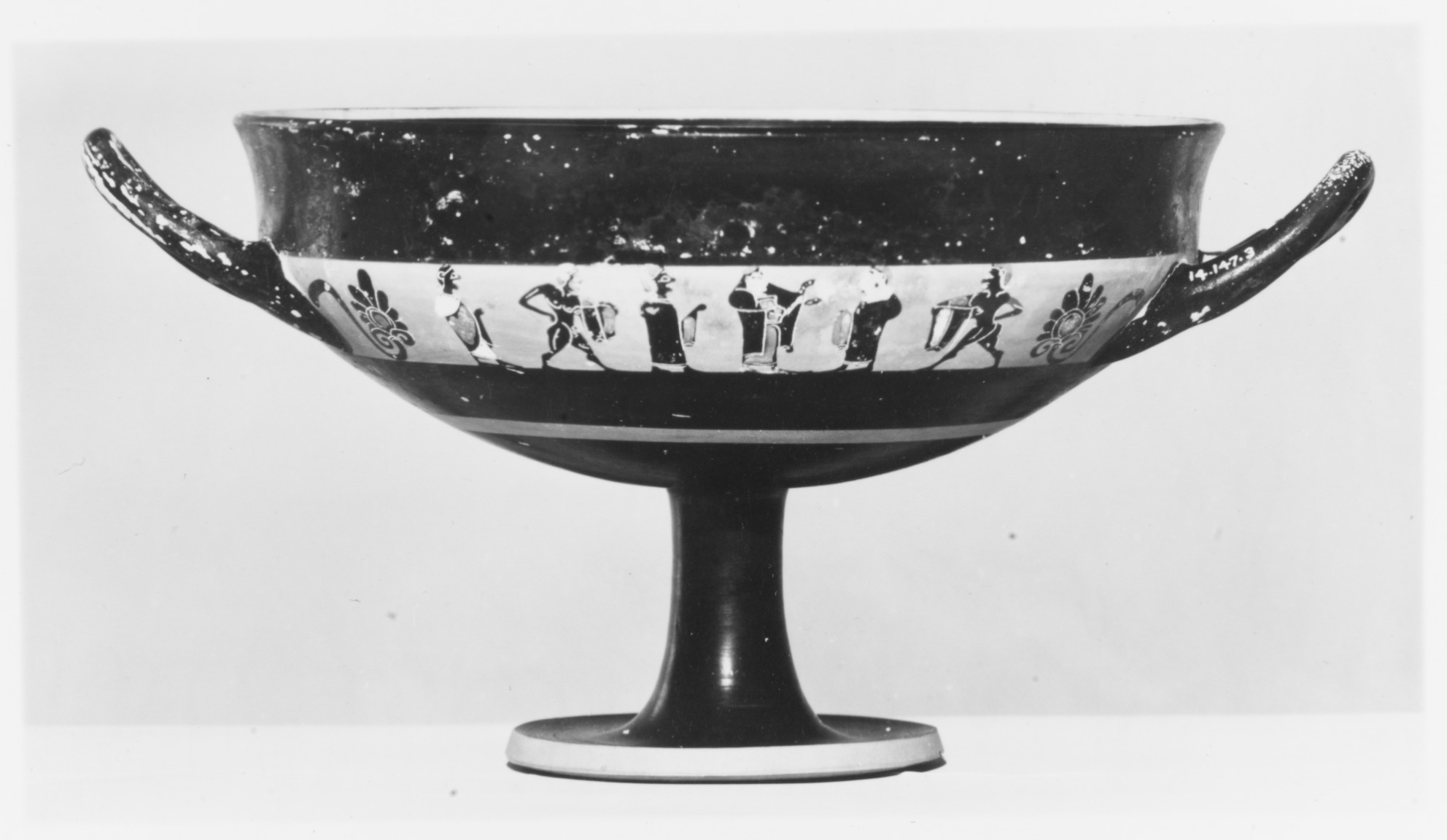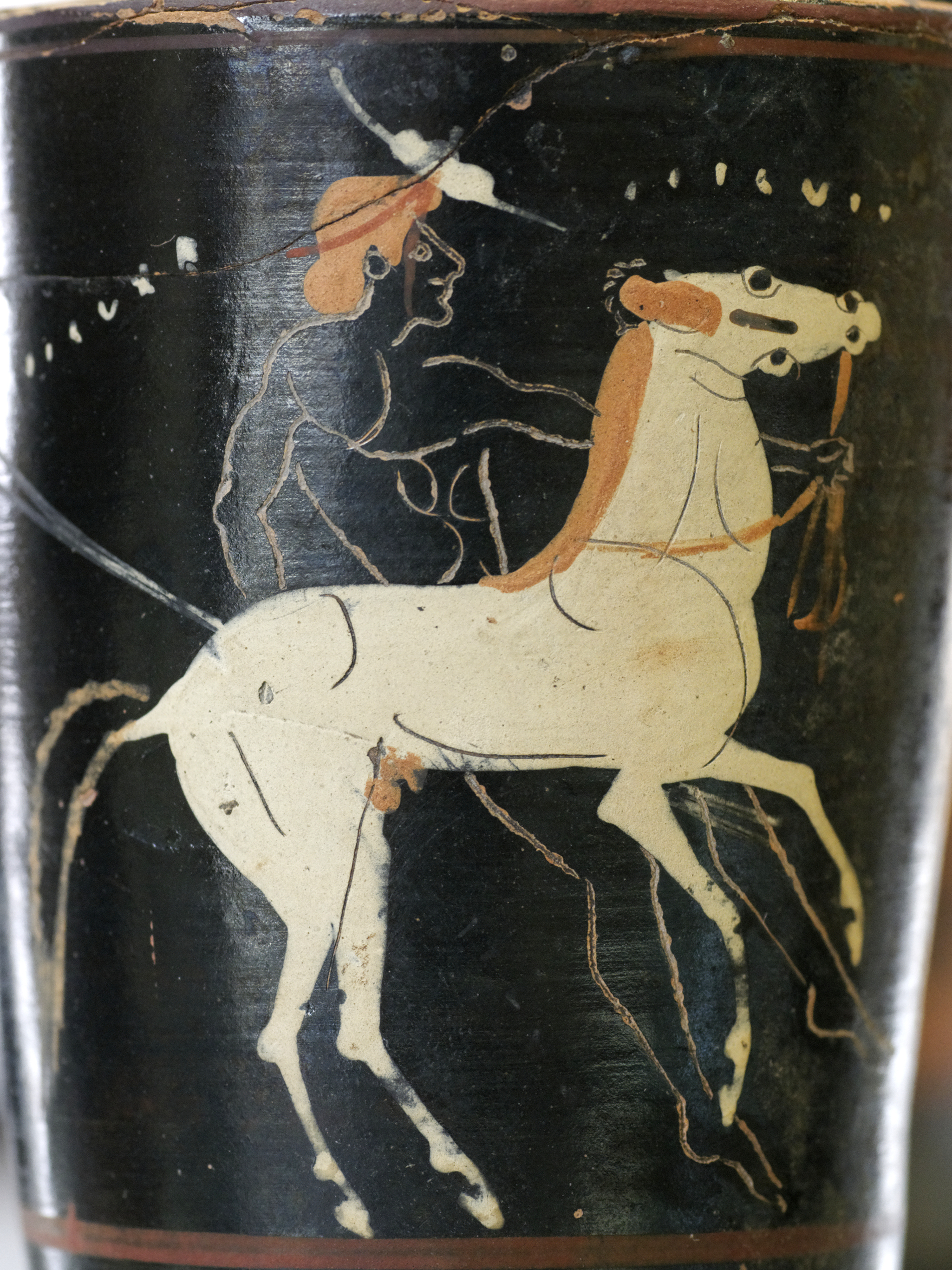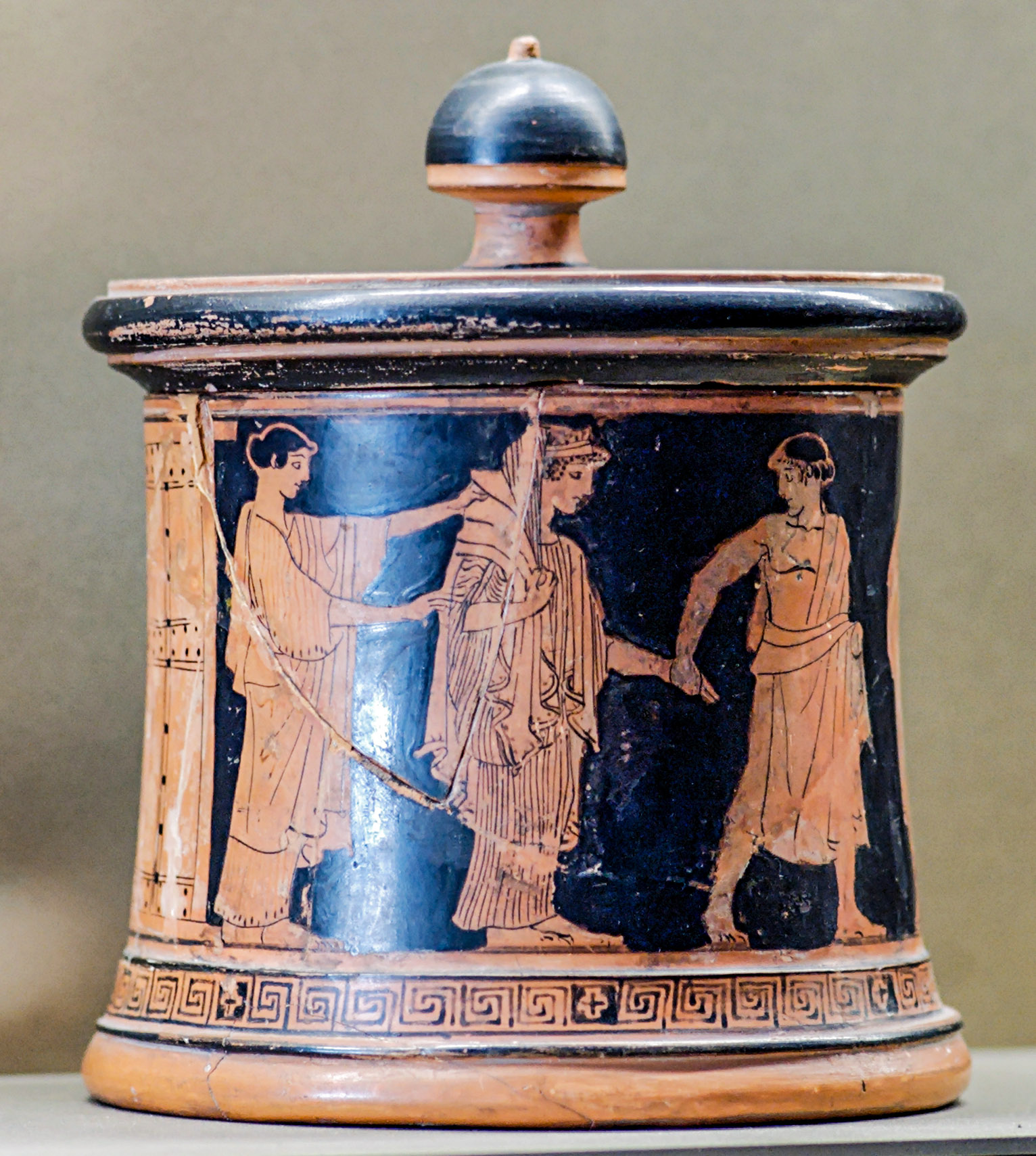|
Nikosthenes
Nikosthenes was a potter of Greek black- and red-figure pottery in the time window 550–510 BC. He signed as the potter on over 120 black-figure vases, but only nine red-figure. Most of his vases were painted by someone else, called Painter N (for Nikosthenes). Beazley considers the painting "slovenly and dissolute;" that is, not of high quality. In addition, he is thought to have worked with the painters Anakles, Oltos, Lydos and Epiktetos. Six's technique is believed to have been invented in Nikosthenes' workshop, possibly by Nikosthenes himself, around 530 BC. He is considered transitional between black-figure and red-figure pottery. The pottery workshop Nikosthenes was the owner of a workshop in Athens in the latter part of the 6th century BC. On the theory that the number of signed works reflects the number of total works, the high number of signatures referring to Nikosthenes suggests that he had one of the largest if not the largest manufacturing center in Athens. He ... [...More Info...] [...Related Items...] OR: [Wikipedia] [Google] [Baidu] |
Black-figure Pottery
Black-figure pottery painting, also known as the black-figure style or black-figure ceramic ( grc, , }), is one of the styles of painting on antique Greek vases. It was especially common between the 7th and 5th centuries BCE, although there are specimens dating as late as the 2nd century BCE. Stylistically it can be distinguished from the preceding orientalizing period and the subsequent red-figure pottery style. Figures and ornaments were painted on the body of the vessel using shapes and colors reminiscent of silhouettes. Delicate contours were incised into the paint before firing, and details could be reinforced and highlighted with opaque colors, usually white and red. The principal centers for this style were initially the commercial hub Corinth, and later Athens. Other important production sites are known to have been in Laconia, Boeotia, eastern Greece, and Italy. Particularly in Italy individual styles developed which were at least in part intended for the Etruscan ... [...More Info...] [...Related Items...] OR: [Wikipedia] [Google] [Baidu] |
Nikosthenic Amphora
A Nikosthenic amphora is a type of Attic vase invented in the late 6th century BC by the potter Nikosthenes, aimed specifically for export to Etruria. Inspired by Etruscan Bucchero types, it is the characteristic product of the Nikosthenes-Pamphaios workshop. Characteristic features are the angular body of the amphora and the broad flat handles. The Etruscan predecessors were black-painted, whereas the Attic vases were decorated in the black-figure style. Nearly all know examples were found in Caere, while the majority of Nikosthenes products in other shapes were discovered in Vulci. This suggests that the type was specifically made for sale in or to Caere, which indicates that Nikosthenes must have been a gifted salesman and that an efficient system of intermediate traders must have existed. Niksothenes created or introduced several vase shapes, but the Nikosthenic amphora is his most famous innovation. The clay of the Nikosthenic amphorae is bright orange-red, and thus provi ... [...More Info...] [...Related Items...] OR: [Wikipedia] [Google] [Baidu] |
Pamphaios
Pamphaios was an Attic potter active around the end of the 6th century BC. Pamphaios was the successor of Nikosthenes in that artist's workshop, and thus took over from one of the most influential and creative potters of antiquity. He probably took over the workshop before 510 BC and continued the tradition of his predecessor by producing typical shapes the latter had developed, such as the Nikosthenic amphora, the Nikosthenic pyxis or the Chalkidian style cup. At times, he developed these shapes further. Unlike Nikostehenes, Pamphaios favoured painters of the red-figure style, which was at the time replacing the previously dominant technique of black-figure vase painting. He also continued to employ many of the painters that had worked for Nikosthenes, such as Oltos, Epiktetos and the Nikosthenes Painter. Pamphaios signature survives on more than fifty vases – spelled different ways by various artists, it probably functioned as a trademark on his workshop's products. File:At ... [...More Info...] [...Related Items...] OR: [Wikipedia] [Google] [Baidu] |
BMN Painter
The BMN Painter was an Attic vase painter in the black-figure style, active during the third quarter of the 6th century BC. Initially, the BMN Painter worked for the potter Lydos. Of the collaboration between the two, a band cup and a belly amphora are known. John Boardman sees the BMN Painter as both the earliest and the best vase painters to collaborate with the important potter Nikosthenes. The earliest works by them are a Siana cup and several Little-master cups, including a lip cup signed by Nikosthenes. The BMN Painter was the most significant representative of the Bellerophontes Class. He probably painted the majority of works by that grouping, including the name vase, depicting Bellerophontes fighting the chimaira. The abbreviation BMN that provides his covnetional name stands for "British Museum" and "Nikosthenes" and refers to his name vase, inventory B 295 in that museum. Bibliography * John Beazley Sir John Davidson Beazley, (; 13 September 1885 – 6 May ... [...More Info...] [...Related Items...] OR: [Wikipedia] [Google] [Baidu] |
Painter N
The N Painter was an Attic black-figure vase painter of the third quarter of the 6th century BC. His real name remains unknown. The N Painter was named after the potter Nikosthenes, as he worked in the latter's workshop and was his most important collaborator. Modern scholarship assumes that N Painter painted all known Nikosthenic amphorae. He also decorated several '' kyathoi'', cups and a ''psykter A psykter (in Greek ψυκτήρ "cooler") is a type of Greek vase that is characterized by a bulbous body set on a high, narrow foot. It was used as a wine cooler, and specifically as part of the elite sympotic set in the ancient Greek symposium. ...''. Some scholars suggest that N Painter and the potter Nikosthenes may be identical. The vases painted by N Painter are mostly dated to the 530s and 520 BC. Especially his larger figures are of considerable quality, while John Boardman condemns his smaller works as simply boring and sometimes sloppy, not very different from mass-pro ... [...More Info...] [...Related Items...] OR: [Wikipedia] [Google] [Baidu] |
Psiax
Psiax was an Attic vase painter of the transitional period between the black-figure and red-figure styles. His works date to ''circa'' 525 to 505 BC and comprise about 60 surviving vases, two of which bear his signature. Initially he was allocated the name "Menon Painter" by John Beazley. Only later was it realised that the artist was identical with the painters signing as "Psiax". Psiax collaborated with the potters Hilinos, Menon, Andokides and Nikosthenes. While he started as a painter in the black-figure technique, he played a major role in the early development of red-figure, which was invented in the workshop of Andokides. The black-figure Antimenes Painter, working for the same workshop, was stylistically close to Psiax; Beazley described the two as "brothers". Perhaps unsurprisingly, considering his chronological position, Psiax was a master of bilingual vase painting. Formerly called the Menon Painter, after the potter’s signature on a red-figure amphora (Philadelph ... [...More Info...] [...Related Items...] OR: [Wikipedia] [Google] [Baidu] |
Lydos
Lydos (Greek: Λυδός, ''the Lydian'') was an Attic vase painter in the black-figure style. Active between about 560 and 540 BC, he was the main representative of the '’’Lydos Group’’’. His signature, ό Λυδός, ho Lydos ("the Lydian)", inscribed on two vases, is informative regarding the cultural background of the artist. Either he immigrated to Athens from the Lydian empire of King Kroisos, or he was born in Athens as the son of Lydian parents. In any case, he learned his trade in Athens. Style It is difficult to definitely recognise his work, since he was the centre and main artist of a highly productive Attic pottery workshop. For that reason, many vases are simply described as "in the style of Lydos". Several other individual artists within his circle can be identified, including the Painter of Vatican 309 and Painter of Louvre F 6. These works are quite homogeneous in style, but differ considerably in terms of quality. The style of Lydos strongly resem ... [...More Info...] [...Related Items...] OR: [Wikipedia] [Google] [Baidu] |
Anakles
Anakles was a 6th-century B.C. Greek vase-painter whose work was closely associated with that of Nikosthenes with whom he may have been in partnership."Nikosthenes" in ''The Oxford Encyclopedia of Classical Art and Architecture''. Ed. John B. Hattendorf. Oxford University Press, 2007. Online edition. Accessed 19 January 2012. See also * List of Greek vase painters A ''list'' is any set of items in a row. List or lists may also refer to: People * List (surname) Organizations * List College, an undergraduate division of the Jewish Theological Seminary of America * SC Germania List, German rugby uni ... References External links * Walters, H.B. & Birch, S. (1905) ''History of ancient pottery: Greek, Etruscan, and Roman''Vol. I free download here. [...More Info...] [...Related Items...] OR: [Wikipedia] [Google] [Baidu] |
Epiktetos
Epiktetos was an Attic vase painter in the early red-figure style. Besides Oltos, he was the most important painter of the Pioneer Group. He was active between 520 BC and 490 BC. His name translates as "newly acquired", which is most probably a reference to his slave status. Career At the beginning of his career, Epiktetos painted a chalice krater made by the potter Andokides, but later he turned to smaller vessels, such as cups and plates. Throughout his long career, he worked for a variety of potters, including Andokides, Hischylos and the Nikosthenes-Pamphaios workshop. Since he signed one plate as painter and potter, he may have carried out both functions at least for some of the time. That plate was a votive offering, dedicated on the Athenian Acropolis. On one kylix, he collaborated with the Euergides Painter. He appears to have been aware of his talent, as he signed more than half of the works ascribed to him. His first vases were bilingual eye-cups. The eight bi ... [...More Info...] [...Related Items...] OR: [Wikipedia] [Google] [Baidu] |
Oltos
Oltos was a Late Archaic Greek vase painter, active in Athens from 525 BC to 500 BC. About 150 works by him are known. Two pieces, a cup in Berlin ( Antikensammlung F 2264) and a cup in Tarquinia (Museo Nazionale Tarquiniese RC 6848), are signed by him as painter. Overview Oltos is thought to have begun his career in the workshop of the potter Nikosthenes. Initially, he mainly painted bilingual vases or bowls with interior black-figure and exterior red-figure decoration. His black-figure style was influenced by Psiax and the Antimenes Painter. No pure black-figure works by Oltos are yet known. His tondos usually depict a single figure. They are often full of tension, frequently with differential directions of gaze and movement. Later, he exclusively painted red-figure, influenced especially by the Andokides Painter as well as several members of the Pioneer Group, especially his former pupil Euphronios. His drawing style was spacious and elegant, but never reached the d ... [...More Info...] [...Related Items...] OR: [Wikipedia] [Google] [Baidu] |
Six's Technique
Six's technique is the modern name for a technique used by Attic black-figure vase painters that involves laying on figures in white or red on a black surface and incising the details so that the black shows through. It was first described by the Dutch scholar Jan Six in 1888, and was given its English name by J. D. Beazley.Beazley, in ''Greek Vases in Poland'', 1928 Around 530 BCE, the technique began to be used regularly for decorating the whole vase, rather than for details as in previous practice. The effect is similar to red-figure painting. Nikosthenes, Psiax, and the Diosphos Painter were among the early users of the technique. It remained in use until the mid-5th century, when it can be observed on a small number of oenochoe from the Haimon painter workshop. See also * Corpus vasorum antiquorum Corpus Vasorum Antiquorum ("corpus of ancient vases"; abbreviated CVA) is an international research project for documentation of ancient ceramics. Its original ideal target c ... [...More Info...] [...Related Items...] OR: [Wikipedia] [Google] [Baidu] |
Pyxis (vessel)
A ''pyxis'' (, plural ''pyxides'') is a shape of vessel from the classical world, usually a cylindrical box with a separate lid. Originally mostly used by women to hold cosmetics, trinkets or jewellery, surviving ''pyxides'' are mostly Greek pottery, but especially in later periods may be in wood, metal, ivory, or other materials. The name derived from Corinthian boxes made of wood from the tree ''puksos'' (boxwood), that also came with covers. The shape of the vessel can be traced in pottery back to the Protogeometric period in Athens, however the Athenian ''pyxis'' has various shapes itself. At first, the two varieties of ''pyxis'' included the pointed and the flat-bottomed. The pointed ''pyxis'' didn't last much longer than the ninth century BCE, while the flat-bottomed continued into the late Geometric. It also continued to grow larger and more squat in proportions. The cover often depicts elaborately sculpted handles and the walls tend to be somewhat convex. During the ... [...More Info...] [...Related Items...] OR: [Wikipedia] [Google] [Baidu] |




